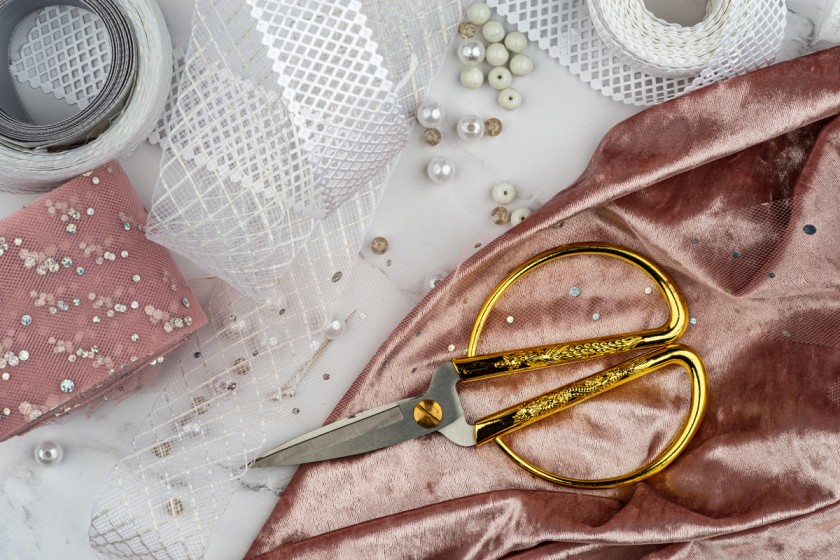How Can You Source Customized Fabrics And Trims Online?



Do you have an innovative idea for starting a clothing line? Or, do you plan to help brands bridge the gap between designing and production like a freelancer? Either way, you need to figure out how you are going to source fabric.
Going ahead with a clothing line involves a lot of components. Beginning with a solid foundation and supreme quality materials can make one shine out in the crowd. There are two major pillars of a clothing business: fabric and trims. Material that a designer will require other than fabric to make apparel is called trims. It can be threads, shoulder pads, velcro, beads, buttons, zippers, motifs, and so on.
The right combination can take any business to the pinnacle of success and vice-versa. It will determine how the apparel will look and feel. This selection will also affect other aspects of the brand, like fitting, durability, and comfort of the garment. Currently, four major types of fabrics are trending in 2022. They are knit, yarn-dyed, woven, and printed.
Similarly, there are different fabric techniques like printing, weaving, and knitting. Choosing the right fabric is the first step of the designing process for many fashion designers.
To save time and energy, designers don’t mind weighing the online options for fabric and trims sourcing. However, this entire process can be overwhelming for beginners. It is what this blog post will be about. We will outline some tips to source the finest customized fabrics and trims online.
Before Starting the Fabric Sourcing Process
Here are a few things fashion designers must consider before starting the process of fabric sourcing.
- What One Wants to Make? - Designers must ponder upon the range of garments they would like to make in a particular season. It can be anything like starting a hemp brand or going for a sustainable fashion line. Designers can also conduct surveys and market research to determine their final collection.
- Identify the Niche – The second thing designers need to work upon is identifying their niche. Is it specifically for women, men, or something androgynous? Moreover, is it going to be regular wear, party wear, or a mix of both? Finding the niche is like giving a direction to the business vision.
- Identify End Consumers – Identifying who will be investing in the clothes is also crucial. It will help the designers create and innovate as per the needs and expectations of the consumers. Designers can observe their competitors and come up with innovative clothing collections. It will help them stand out in the crowd and please the consumers with unique apparel collections.
- Research – Understanding the nuances of current fashion industry trends and working style is essential to crave a niche in the competition. A systematic research approach can help designers attain objectives here. For instance, a brand planning to go for sustainable clothing must know the manufacturing standards and guidelines. Apart from this, it should also know the key players in the market and analyze their production and sourcing processes.
Experts say designers must have a good understanding of what they are making and whom they are targeting. They should take their time and do thorough research before jumping into fabric sourcing and product development.
Types of Fabric Suppliers

Creating a foundation of trustworthy customized fabric and trim suppliers is crucial for every clothing business. Experts recommend partnering with the ones that can guarantee on-time delivery and quality materials. Here is a list of different kinds of fabric suppliers. We will also explain the variety of fabrics they stock and how they operate.
- Fabric Mills – Fabric mills are textile manufacturing units. They produce and process a wide range of fabrics. The best part about fabric mills is that they also provide custom-made textiles and cater to minimum order requirements. However, designers must ensure they discuss all the terms and conditions for a hassle-free production process.
- Converter – Clothing brands looking for more sourcing options can buy fabric from converters. These are the companies that purchase unfinished textiles from the manufacturer directly. They then finish the fabric by dying and printing, and selling it to clothing brands.
- Jobbers – These suppliers create their stock from the left-out materials of mills and converters. They sell these fabrics at affordable rates to fashion designers and clothing brands. However, designers cannot expect to reorder the same fabric again as Jobbers usually don’t restock a print, textile, or color.
- Full Package Production (FPP) – An FPP provider can help designers in the extensive garment production of their startup clothing line. They can also source customized fabrics and trims from FPP. It is a one-stop solution that can help designers in every step of their textile production process.
How to Source Customised Fabrics and Trims Online?

Fabric sourcing is not an easy task. The complications can multiply for beginners when they plan to source it online. But not anymore. Here is a detailed guide on sourcing the right fabrics and trims from online platforms.
- Analyze the Online Platforms – There are hundreds of fabric suppliers that cater to online customers. Designers who want to source fabric online should first of all study these platforms and pick the most reliable ones. However, they must ensure that they go for an online platform that guarantees supreme quality fabrics and trims at the best rates.
- Enquire about Basic Requirements – The second thing designers need to do is inquire about the minimum order requirements. The majority of the online customized fabric suppliers cater to bulk orders. And any brand that is seeking online suppliers for smaller orders should first check with their basic requirements.
- Ask for Samples – Not many designers know that online platforms provide fabric samples for approval and quality check. That’s not all. Designers can also see the product details online for specific fabrics. Designers can also make sample garments to check the durability, drape, and flow. Moreover, they can also connect with the customer helpdesk for more details. It will help them pick the right fabric quality for the right garment.
- Enquire about the Origin of Fabric – Unfortunately, many designers forget or skip this factor while sourcing fabrics online. However, it is crucial to enquire about the origin of the fabric they are planning to buy online. Should designers go for domestically produced fabrics or international fabrics? Well, experts recommend going for domestically produced textiles. It will be affordable and guarantees quality. Internationally crafted fabrics are expensive and carry a higher surcharge with them. It means that the textile alone will cost around 28%-30% of the whole order. All this can substantially increase the apparel cost.
- Consider the Price – Temptation is something designers need to work upon seeing the versatile types of fabric options online. Going out of the budget in the first buy is not recommended. So, they must go for a fabric that justifies the price and can be approachable in the upcoming times. Designers can wait for season-end sales and discount offers to get the best deals.
- Fabric Details – One should ensure to cross-check details like fabric weight, width, color availability, fiber content, and so on before placing the order. All the details should be as per the client and order requirement. Designers can also consult with market experts to know about the nuances of fabric sourcing.
- Payment Terms – Designers must be clear about the terms and modes of payments to avoid inconveniences later. In case of any confusion or query, one should feel free to reach out to the customer service executive. If opting for an international brand, one should ensure the confirmation of the final amount in INR. Last but most importantly, one should check the credibility of the online platform before initiating the payment process. There are multiple ways to check if a website is authentic or not. One can take the help of the internet in this regard.
- Receiving the Order – Most fabric suppliers use DHL, FedEx, UPS, so on to ship the fabric order. Designers must ensure that they provide the right shipping address to the supplier. Apart from this, they should carry the payment slip and the tracking ID to receive their order.
Bottomline
So, this was all about sourcing customized fabric and trims from an online platform. Beginners are advised to take wise decisions while sourcing fabrics online. They should place orders considering their business objectives, budget, and client quality requirements. Moreover, they should go for reputed and trustworthy suppliers only. One wrong decision can hamper the image of the brand in the market.
Apart from this, brands facing supplier-related issues should get in touch with Fashinza. It is a leading B2B apparel producing platform. They also help fashion brands to collaborate with reliable suppliers. In a nutshell, Fashinza aims to make the entire garment manufacturing process faster, transparent, and hassle-free for all clothing brands.



















